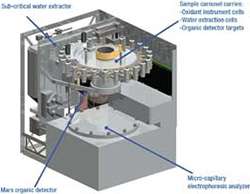Life-Probing Instrument Preparing for Mission to Mars

A new life-detecting instrument is preparing for a mission to the Red Planet. The Urey: Mars Organic and Oxidant Detector instrument, developed by a scientist at Scripps Institution of Oceanography at UC San Diego, received approximately $2 million in NASA funding to further refine the design and technology for the European Space Agency's (ESA) 2013 ExoMars Rover Mission.
Named after the late Nobel Laureate and UC San Diego scholar Harold C. Urey, the Urey instrument will perform the first search for key classes of organic molecules in the Martian environment using state-of-the-art analytical methods at part-per-million sensitivities. This highly sensitive instrument is the first with the capability to effectively discriminate between Martian materials produced by biological and non-biological processes. In addition, the investigation will provide definitive oxidation characteristics of those same samples.
Jeffrey Bada of Scripps Oceanography, along with a multinational research team including colleagues Frank Grunthaner of the NASA Jet Propulsion Laboratory, Richard Mathies of UC Berkeley, Aaron Zent of the NASA Ames Research Center, Richard Quinn of the SETI Institute, Pascale Ehrenfreund of the NASA Goddard Spaceflight Center and Mark Sephton of Imperial College, London have designed an investigation using the Urey instrument to look for signs of past or present life on Mars. It will analyze Martian rock and soil samples provided by the ESA-developed ExoMars Rover, for organic molecules and amino acids, the building blocks of life. Urey will be built and tested at the NASA Jet Propulsion Laboratory (JPL) in Pasadena, Calif.
“This next phase of funding assures that the Urey instrument’s design will be completed on schedule and we will be prepared to start building the actual instrument next year,” said Bada, professor of marine chemistry at Scripps and principal investigator of the Urey investigation.
The instrument has been supported by NASA Research and Development funding for the past several years leading up to this transition to Phase A Flight planning and design.
The Urey instrument has been identified as an integral component of ExoMars, a six-month mission on the Red Planet and ESA’s first rover mission to Mars. “We will be working very closely with our European partners over the next year to finalize interfaces and to further solidify how Urey fits into the overall ExoMars payload system,” said Allen Farrington, project manager of the Urey development team at JPL.
A compact instrument that can be held in the palm of one’s hand, Urey will search for trace levels of amine-containing organic molecules by “making espresso” from spoon-sized amounts of Martian soil, freeze drying the liquid to remove the water, and then slowly re-heating the residue, and concentrating the organic molecules by condensing them on a cold trap. A lab-on-a-chip, micro-fluidic, laser-induced fluorescence detector initially developed by team members at UC Berkeley will probe the trap’s contents.
In addition to the organic compound analyses, Urey will also test the Martian samples and environment for their ability to degrade organic compounds through oxidation. The Mars Oxidant Instrument developed by team members at NASA Ames Research Center, JPL and the SETI Institute will enable the scientists to evaluate the stability of compounds directly under Martian conditions. Even if no organic compounds are detected, this oxidation information will provide important data for understanding the reasons why organic compounds might not be preserved on Mars.
Source: University of California, San Diego





















